
_______________________
_______________________
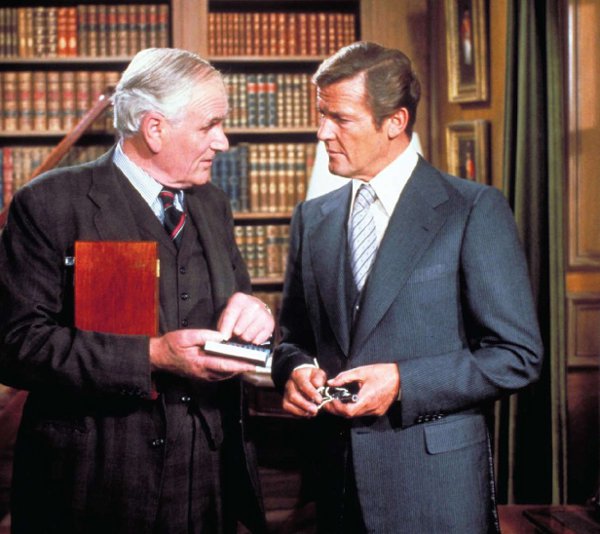
We must get them in the shops for Christmas, Q.
BOND ON GADGETS
Almost every Bond film features a trip into Q-Branch, an underground Aladdin’s cave-like bunker beneath the power desks of MI6, where a group of boffins led by their Quartermaster feverishly develop and invent wonderful gadgets, gizmos and accoutrements for the field operatives of Her Majesty’s Secret Service. It’s unclear just how many of these devices are ever returned; certainly if Jim is a yardstick then very few come back intact.
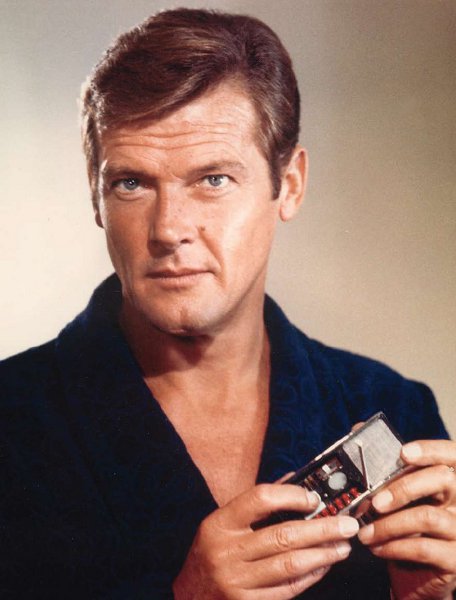
One of my first 007 gadgets. A radio transmitter housed in a hairbrush.
FINDING Q
While being one of the most well known and favourite of the returning characters, Q’s origins are not terribly clear. There is a reference to Q in Chapter 3 of Fleming’s Casino Royale. M says to Bond, ‘Go over a few days before the big game starts and get your hand in. Have a talk to Q about rooms and trains, and any equipment you want.’
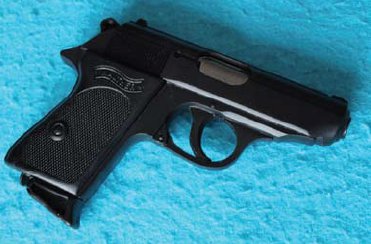
The famous Walther PPK as presented to Jim by ‘The Armourer’ in Dr. No. The PPK was used in most of the films up to Tomorrow Never Dies, and then made a welcome return in Quantum Of Solace.
Q-Branch features occasionally in the novels, supplying Bond with equipment and gadgets, but it is said by scholars that the true origin of the Q character lies in the first film, Dr. No. The secret service armourer, Major Boothroyd, replaces Jim’s Beretta with a new Walther PPK. There is no direct reference to Boothroyd being associated with Q Branch, though the character was based on a real person who advised Fleming on changing Bond’s weapon, Major Geoffrey Boothroyd.
In the next film, Desmond Llewelyn’s character is referred to as the ‘Equipments Officer’, when he supplies Jim with his new attaché case, although he is credited as Boothroyd in the closing titles. Of course, forever after we knew him as Q, which to my mind is far less confusing.

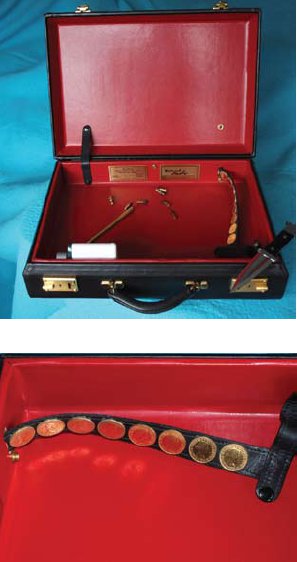
The first real gadget was the attaché case in From Russia With Love. It included twenty gold sovereigns, a throwing knife (this original design is by Pinewood effects engineer Bert Luxford), a tear gas canister and hidden ammunition.
Desmond Llewelyn played Q from 1963 to 1999 in a total of seventeen films. On screen, he was the gadget master who invented wonderful, never-before-seen devices, whereas off screen Desmond was a complete technophobe who struggled even to operate his own video recorder.
Desmond was not in Dr. No; that was Peter Burton. However, when Burton proved unavailable for From Russia With Love, Terence Young cast Desmond after remembering him from a few years earlier in a film called They Were Not Divided.
When Desmond arrived on set Terence asked him how he was going to play the character. ‘As an English civil servant,’ Desmond replied.
‘No, you’re a Welshman. Play it as a Welshman,’ said Terence.
Desmond argued that a Welsh accent wouldn’t carry the air of authority he felt the character should have. Nevertheless, he did as his director asked and put on a very broad Welsh accent.
‘Well, look-see, I have this smashing case for you … press this ’ere button and out pops a lovely knife …’
‘No, you’re quite right,’ said Terence. ‘Play it as you thought.’
On the next film, Goldfinger, the character was really rounded out. Guy Hamilton told me that when Sean entered Q-Branch, Desmond stood up to greet him.
‘No! No! No!’ said Guy. ‘You hate this man. He destroys everything you ever give him. You have nothing but contempt for him! Don’t stand up to greet him.’
From then on, Q treated Bond with a circumspect irritation and established that wonderful love–hate relationship that lasted throughout the series.
Q’s appearance in a Bond film was always highly anticipated, so you can imagine my disappointment when he wasn’t in Live And Let Die. Apparently, it was decided that Bond was relying a little too much on gadgets, and Q would therefore be dropped.
However, there was such an outcry after the film’s release that Q was immediately written back into the next film.
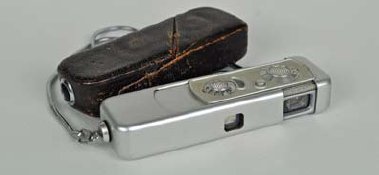
The miniature spy camera from On Her Majesty’s Secret Service, that Jim used to photograph Blofeld’s Angels of Death.
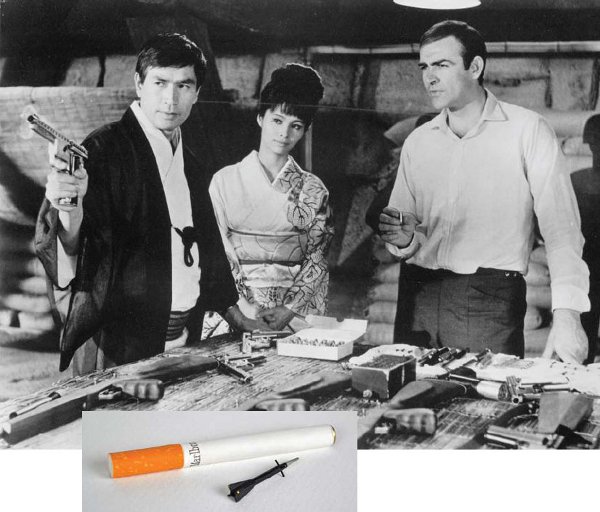
In Japan, Tiger Tanaka demonstrated the rocket-firing cigarette to Bond. They say smoking kills …
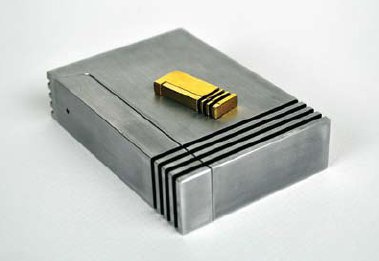
In Goldfinger, early GPS-style technology was employed in these two tracking devices. One was affixed to Auric Goldfinger’s car while the other, smaller, device was hidden in Jim’s shoe.
EVIL PERSONIFIED (ME, THAT IS)
Desmond always struggled to learn his dialogue, as after all, it was usually quite technical. I, being a caring and kind performer, noticed this early on in our working relationship and decided to take full, evil advantage of it.
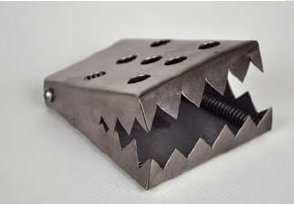
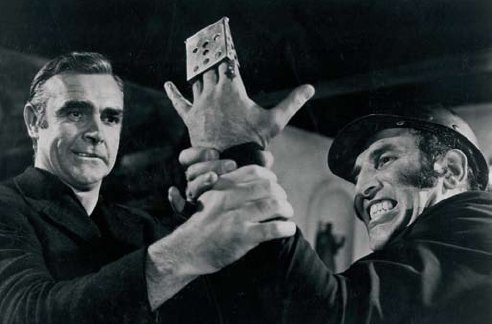
Beware of pickpockets … or should that be, beware pickpocketers. A finger trap slipped in the inside jacket pocket gives any hoodlum in search of your gun a nasty snap.
Lewis Gilbert, who had directed You Only Live Twice, told me how Desmond complained about having to wear shorts in the movie. He didn’t particularly like exposing his legs to the elements, and so whenever Desmond was in earshot I’d say quietly to Lewis, ‘Oh, do you think it would work better if Q were to wear shorts in this sequence?’
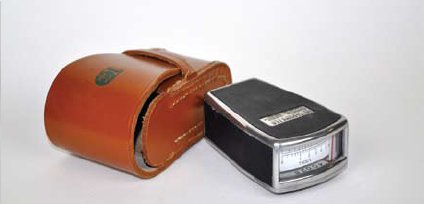
The bug detector, used by Bond in his Istanbul hotel room. Walls have ears, you know.
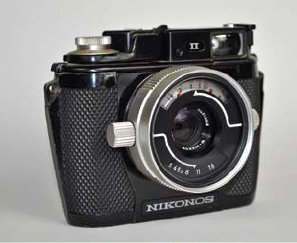
The Nikon underwater camera – a prototype for future technology, as were many of the early Q-Branch gadgets – was first seen in Thunderball.
‘Eh? What?’ said a worried Desmond.
‘Yes, good idea, Rog!’ Lewis replied. ‘And perhaps in the next sequence too?’
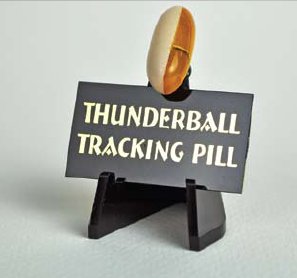
In Thunderball, Jim was issued with another tracking device, but this one used (harmless) radioactivity principles and took the form of an everyday pill.
Then I was particularly evil in rewriting his dialogue with the script supervisor, June Randall, and handing it to director John Glen to give to Desmond when he arrived at the studio. My rewrite was, of course, the biggest load of gibberish you can imagine. Desmond had already struggled to learn his lines and went into a blind panic when he was handed new pages so soon before being called on set. Of course, when he was called and saw me slowly shaking with stifled laughter, the penny dropped, as did a few choice words.
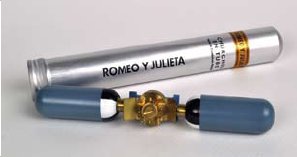
The underwater breather, which as well as appearing in Thunderball, made a return in Die Another Day. The air supply lasts for as long as you can hold your breath!
Sometimes we had ‘idiot boards’ on set, with his technical dialogue written in large text. As he glanced up to remind himself of the next line, the cards were peeled back one after the other. I helpfully rewrote some of those too. I like being helpful.
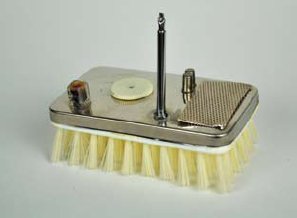
The radio transmitter hairbrush was very neat.
Desmond was always keen that his part be extended, and it finally was in Licence To Kill in 1989, but in an early draft of The Man With The Golden Gun by Tom Mankiewicz, he very nearly has an extra scene with me as Bond at Hong Kong airport. In the draft, Q tried to persuade 007 to take a gadget-laden camera with him on his trip. It featured gas ejection, which, by selecting various shutter speeds, instantly solidified anything in its path. Bond said something like, ‘Most ingenious, but I’m sure there’s one thing this contraption can’t do … take a photo.’ Q castigated him for being facetious before adding, ‘Yes you’re right, but I’m working on it …’
It was quite comical. Perhaps too comical? It was cut. After all, Q is quick to remind us, ‘I never joke about my work, 007’.
A TASTE OF THINGS TO COME
While many of Q’s gadgets – highly charged magnetic watches, remote-control cars, a signature gun, underwater cameras, wrist-triggered dart guns, GPS tracking devices, fake fingerprints and acid pens – seemed outlandish and improbable, Desmond always maintained that they were ‘prototypes’ and forerunners of things that did eventually make it into commercial production. In fact, so sought-after were some, that the highest powers in the land weren’t averse to phoning through to the Bond production office for insights into their design. In 1965 the Royal Corps of Engineers, having seen Thunderball, asked the then art department draftsman Peter Lamont, ‘How long can a man use your underwater breather device for?’
His answer was, ‘How long can you hold your breath?’
Although more often than not exasperated, Q has always shown a warm and fatherly concern for 007’s welfare, such as at Bond’s wedding in On Her Majesty’s Secret Service, when he pulled Jim to one side, to say that if there was ever anything Jim needed … oh and the occasion, at the behest of Miss Moneypenny, when Q secretly sneaked gadgets out of MI6 to help Bond survive his vendetta against the drug tyrant Sanchez in Licence To Kill. When he arrived, posing as Bond’s uncle, he flatly told a dismissive 007, ‘If it hadn’t been for Q-Branch, you’d have been dead long ago.’
How true.
In 1999, aged eighty-five, Desmond voiced his concern that he may not be around for many more films. He asked the writers to pave the way for a new Q. In what was to be his last movie, The World Is Not Enough, Desmond’s Q talks of his plan to retire and go fishing. A crestfallen Bond says, ‘You’re not planning on retiring any time soon, are you?’
Q: ‘I’ve always tried to teach you two things: First, never let them see you bleed.’
Bond: ‘And the second?’
Q: ‘Always have an escape plan.’
He is then lowered out of view.
When in 1998 Desmond asked me to pen a Foreword for his autobiography, simply entitled, Q, I wrote one of the things I missed most after leaving Bond was him. That was absolutely true. He bore my childish pranks so patiently and, being gadget mad (as my wife will attest), I used to love playing with all the gizmos in Q-Branch.
I was watching Sky news on Sunday 19 December 1999, when I heard the awful news that Desmond had been involved in a car accident. He was returning home to Bexhill from a book signing. He died from his injuries. I was devastated.
A few months later, I attended his memorial service in London and spoke of the gentle gentleman who, despite having hands the size of spades and a total incomprehension of what he was talking about, always managed to explain and demonstrate his devices with great skill and endear himself to millions of fans across the world.
With the reboot of the Bond series in 2006’s Casino Royale and its successor, Quantum Of Solace, the character of Q did not appear, though gadgets were still very much in evidence.
Other actors to have played Q on film include John Cleese in Die Another Day, Geoffrey Bayldon in 1967’s Casino Royale and Alec McCowen in Never Say Never Again, with that wonderful line on Jim’s return to Q-Branch, ‘Good to see you, Mr Bond. Things have been awfully dull around here without you. I hope we’re going to see some gratuitous sex and violence …’
GUNS ’N’ AMMO
Think of 007 and you conjure up images of girls, gadgets and … guns. Yes, Jim’s firearms have played as important a part of his adventures as anything else, and though he has carried many, in the films at least, there has always been one constant in his chamois leather holster – the Walther PPK.
However, the Beretta was the gun Fleming’s literary Bond carried. It was described, by firearm enthusiast Geoffrey Boothroyd in a letter to Fleming, as ‘a lady’s gun, and not a very nice lady at that’. He suggested it had little stopping power and that Bond would be much better served with a revolver such as the Smith & Wesson Centennial Airweight. Fleming thanked Boothroyd for his letter and said he felt Bond ought to have an automatic instead of a revolver, though agreed the Beretta 418 lacked power.
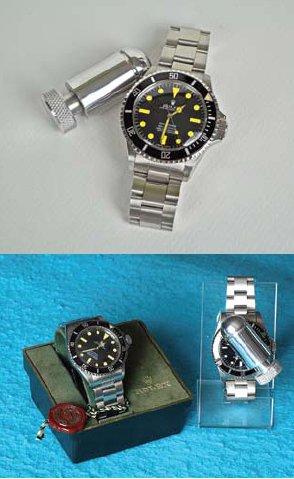
Ah, my favourite gadget – the magnetic Rolex. Ideal for deflecting bullets, attracting gas pellets or for unzipping ladies’ dresses.
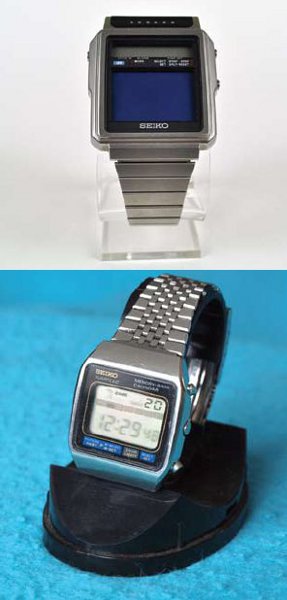
Seiko took over as the official Bond watch suppliers in The Man With The Golden Gun.
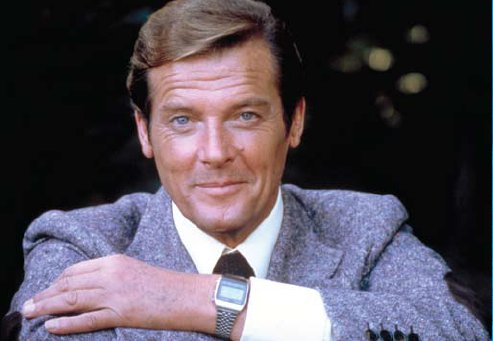
A couple of years on, and Seiko were still supplying 007 with their latest watch. It was waterproof.
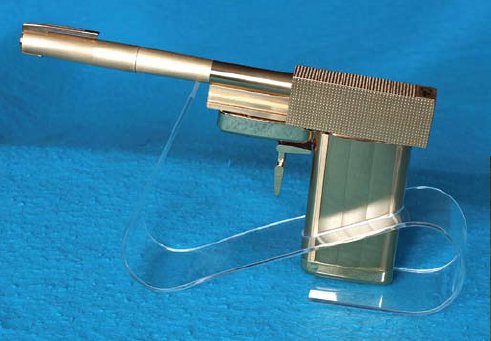
Sometimes the Bond baddies have gadgets too. In The Man With The Golden Gun it came in the shape of … yes, you’ve guessed it, a golden gun. The gun comprised everyday items such as a pen, a cufflink and a cigarette case.
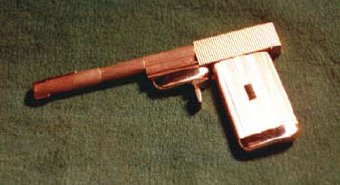
The original, made by Pinewood Effects engineer Bert Luxford.
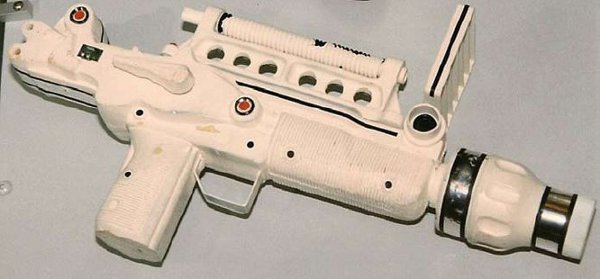
One of the laser guns we used in our space-fight finale in Moonraker.
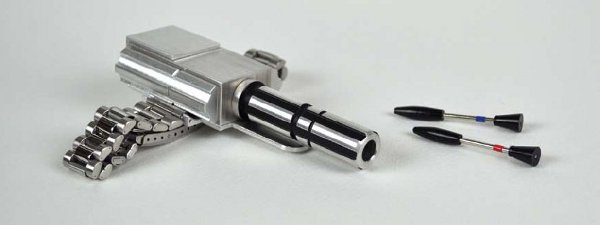
A handy wrist dart gun, as described by Q in Moonraker. Another ‘must’ for Christmas.
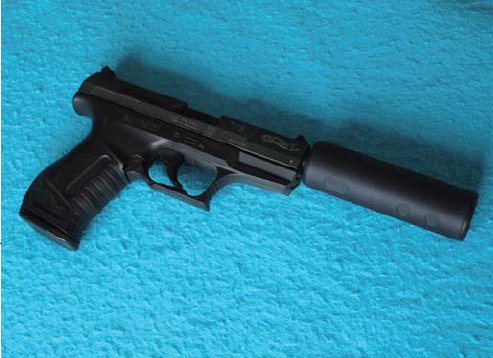
Bond was issued with a new gun in Tomorrow Never Dies, a Walther P99, which he kept for the next few adventures.
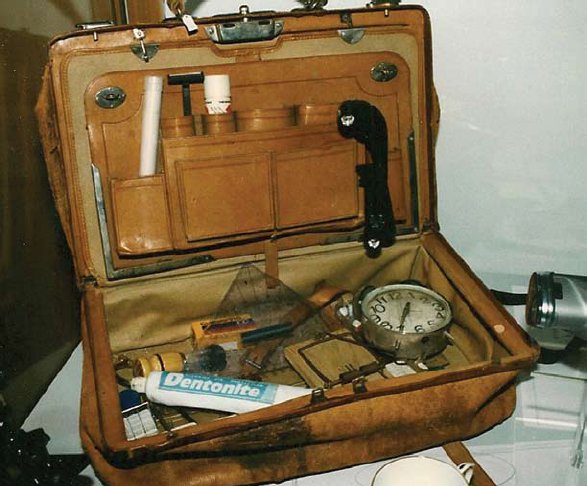
Everything for the traveller abroad – Q’s deadly travel kit includes an alarm clock (guaranteed never to awaken the user) and Dentonite toothpaste, the latest in plastic explosive.
In Dr. No Jimmy was hauled in to M’s office, where we learned he had carried a Beretta for ten years but, on one assignment, the said pistol – with the suppressor attached – snagged in his waistband. He was hospitalized for six months.
Boothroyd recommended the Walther PPK 7.65 mm as being the best choice for an automatic, with ammunition available everywhere. In thanks to Boothroyd, Fleming later called his armourer Major Boothroyd.
The Walther PPK was presented to Jim in Dr. No and was said to have an impact like ‘a brick through a plate-glass window’. I used a PPK in all my films, though it fell out of favour with the real Secret Service when, on 20 March 1974, an attempt was made to kidnap HRH Princess Anne. The police officer protecting the princess was carrying a Walther PPK and it jammed. The gun was subsequently withdrawn from use.
In the Pierce Brosnan films the PPK was updated with a Walther P99, but they reverted to a PPK again with Daniel Craig in Quantum Of Solace. Whenever I had to fire the PPK, I used to anticipate the ‘bang’ and blink. The director would call for us to go again, because I often blinked and winced several seconds before I pulled the trigger. Such a coward.
EXPLOSIVE FUN
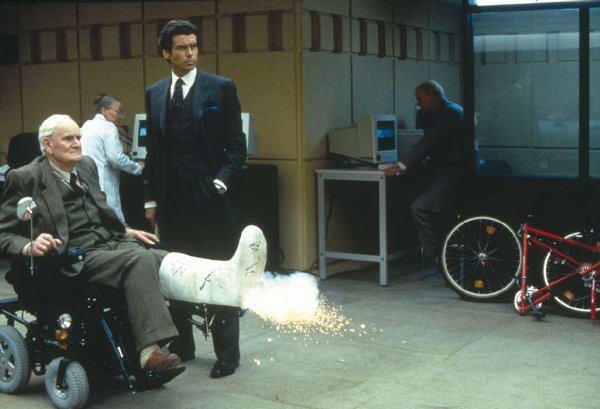
A rocket-firing plaster cast. Only Q could come up with such a novelty!
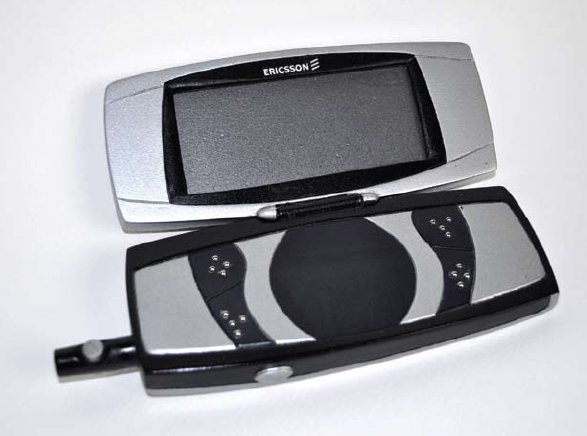
A new Ericsson mobile phone did everything from remotely driving a car to … making a phone call in Tomorrow Never Dies.
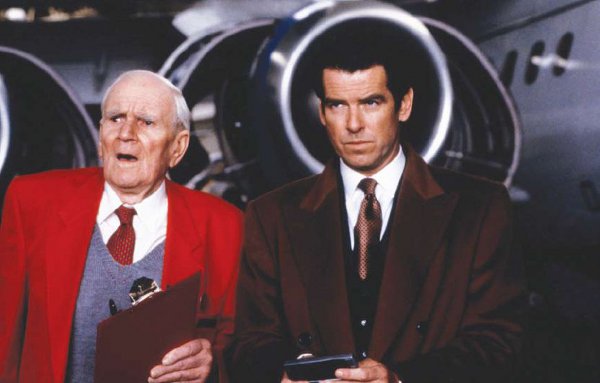
Desmond Llewelyn posing as a car rental salesman at Hamburg Airport in Tomorrow Never Dies. He had a hard time persuading Pierce Brosnan’s Jimmy Bond to take out accident insurance!
The first real Bond gadget was of course the attaché case in From Russia With Love. It contained:
AN AR-7 .22 SURVIVAL RIFLE WITH INFRARED TELESCOPE 50 GOLD SOVEREIGNS
A TEAR GAS CANISTER DISGUISED AS TALCUM POWDER
AMMUNITION FOR RIFLE
A THROWING KNIFE
But should you ever find yourself issued with one, be sure to turn the catches the correct way when opening, or else the tear gas canister will explode in your face.
Terence Young and Peter Hunt decided to have a bit of fun with this element of the case when some United Artists executives were visiting Pinewood. They ran the first couple of reels of the movie, and when it reached the scene where Bond opens the attaché case, Peter cut to the huge explosion from the end of Dr. No and ran the closing titles. The End.
Although he and Terence collapsed in hysterics, the UA execs were not particularly amused. But that was the type of fun you could have on a Bond movie.
In Goldfinger a brilliant set of homing beacons was presented to Jim. The first, larger, one was attached to the villain’s vehicle and its early GPS-type technology used to locate his Swiss base. The second, smaller one, concealed in Jim’s shoe, allowed MI6 to track him. It really was a prototype of GPS as we know it today – and very useful for the likes of jealous wives.
Q came up with some jolly ideas in Thunderball – the first time he was sent on location, incidentally, but Desmond couldn’t sun himself in the Bahamas for continuity reasons – including the Bell Rocket Belt, which was used to propel Bond into the air when escaping Jacques Bouvar; then there was the Underwater Jet Pack used during the final undersea battle. Most usefully, there was an underwater camera capable of taking eight shots in darkness using an infrared film. We take that sort of thing for granted these days, but back then it was revolutionary.
While in Japan, Jim took full advantage of visiting their version of Q-Branch in You Only Live Twice. He marvelled at the mini-rocket cigarette Tiger Tanaka demonstrated – capable of shooting a jet-powered dart accurately up to thirty yards – and quipped, ‘This cigarette can really save your life.’
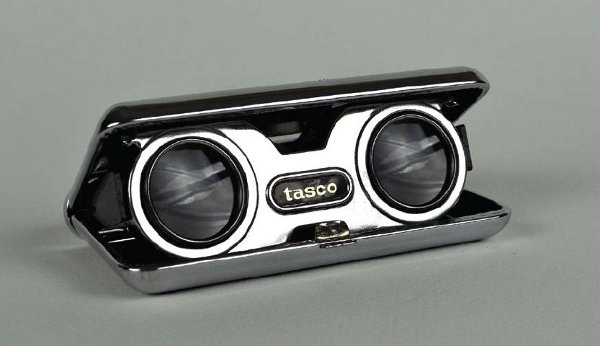
A handy set of folding pocket binoculars.
Then there was dear Little Nellie: the Wallis WA-116 Series 1 autogyro, assembled (and disassembled) to fit into several suitcases. Nellie is armed with rocket launchers, air mines, machine guns, rear-mounted flame-throwers and infrared-guided AA smart missiles. The idea for her inclusion came one morning when Ken Adam heard a radio interview with Nellie’s inventor, Wing Commander Ken Wallis, saying he’d relish the chance to pit his little autogyro against ‘the big boys’. She certainly did him proud in the movie.
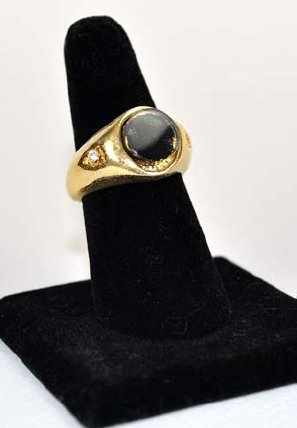
In order to identify a few people in A View To A Kill, Jim is issued with a miniature camera cunningly hidden in his signet ring.
When Sean departed the series and George Lazenby stepped in there was a distinct lack of gadgets. Okay, there was radioactive lint, a safe cracker and a prototype Xerox machine, but not much else to excite us technical geeks. Bond was to rely more on his wits than Q-Branch. Wits are good, but gadgets are fun, and thankfully more were in evidence when Sean returned for Diamonds Are Forever, which featured the pickpocket’s hated snap trap; a fake fingerprint to trick Tiffany Case into believing 007 is Peter Franks; and a voice changer that Blofeld uses to fool employees into thinking he is Willard Whyte and, subsequently, Q uses to fool Blofeld.
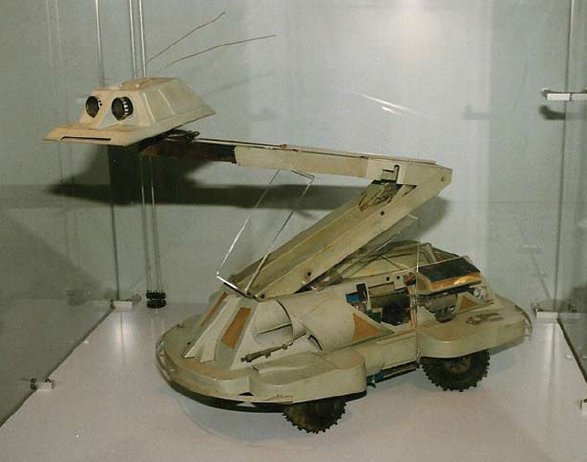
One of Q’s new toys in A View To A Kill was a remote-controlled surveillance device called SNOOPER.
The most profitable of all gadgets, however, was a little ring that prompted every fruit machine to pay out a jackpot. Desmond said he collected up hundreds of dollars’ worth of coins from the machines when the scene was completed, and decided rather than take them home he’d feed them back in to win an even bigger jackpot. Alas, the F/X guys had long gone home and the magic ring was of no use … he lost the lot!
TIME TO PLAY
But more lovely toys were to come when yours truly stepped into the role in 1973. Apart from the Bug Sweeper, a Clothing Brush Communicator, a Shark gun that fired special highly pressurized air pellets and a genuine ‘Felix Lighter’ radio transmitter/receiver, there was a brilliant state-of-the-art Pulsar watch that illuminated to show the digital clock face.
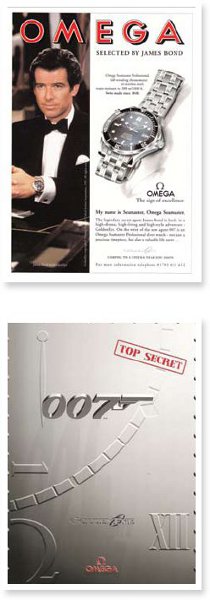
With Pierce Brosnan in GoldenEye came a new watch, the Omega Seamaster.
There was also a lovely Rolex Submariner given to Bond by Moneypenny, after being repaired by Q. This was no ordinary watch. It featured a powerful electromagnet that was said to be able to deflect a bullet. More importantly, it could be used to unzip a lady’s dress. I was ever so disappointed when the F/X boys said it didn’t really work, and that Derek Meddings would instead have his hand up Maddy Smith’s skirt, pulling the zip down using a piece of wire. Lucky old Derek. Constant retakes did mean I got to spend the whole day with dear Maddy, perfecting my technique. Ah, if only I could find a working prototype of that watch today … I could give Maddy a call to see if she fancied re-enacting the scene. The Submariner also featured a spinning bezel that acted as a rotating saw, enabling Jim to cut his rope restraints and escape a pool full of man-eating sharks and then go on and rescue Solitaire.
Did I ever get to keep any of the gadgets, is something I’m often asked. Alas no, they were whisked from set as soon as filming ended for the day. Shame, as I could earn a nice pension on eBay.
In my second outing, it was the villainous Francisco Scaramanga who had the great gadgets. His legendary Golden Gun was assembled from a pen (the barrel) inserted into a cigarette case (the firing chamber), a cigarette lighter (the handle), and a cufflink (the trigger). This gun is limited to just one golden bullet, which are all handcrafted by speciality munitions manufacturer Lazar – they are all 4.2 mm (an unusual size) and made of twenty-three-carat gold. The bullets flatten upon impact.
In The Spy Who Loved Me I of course had the wonderful Lotus Esprit and all its gadgets, but in addition was issued with a handy ski-pole-cum-gun, modified to fire .30-calibre rounds from a four-shot magazine in the handle. I saw Michael Billington off with that.
Then there was a Seiko Quartz watch. It was the second film to feature the brand after a major tie-in for The Man With The Golden Gun, but this was the first film in which it had a purpose – a ticker-tape pager that allowed MI6 to send important messages to Jim. The Seiko was back in Moonraker, though this time with the added bonus of a high explosive charge and remote detonator incorporated. It accompanied the wrist dart gun, capable of firing both cyanide-coated and armour-piercing darts. Jim used that to save himself from an out-of-control centrifuge simulator and then kill Hugo Drax. It’s never a good idea to get into an out-of-control centrifuge simulator without one, let me tell you.
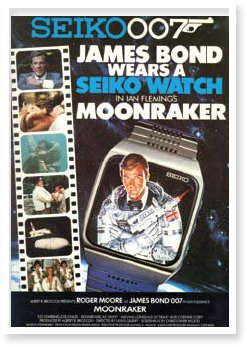
Seiko were with us again on this one.
I was also armed with a safe-cracking device concealed within a cigarette case; a mini-camera imprinted with 007; and a laser gun. Oh, and I stole a poison pen from CIA agent Holly Goodhead’s toys. Bond used this particular gadget to dispose of Drax’s pet python. I think when you have to act alongside a twelve-foot-long rubber snake – and try to appear more animated than it – you know you’ve cracked this acting lark.
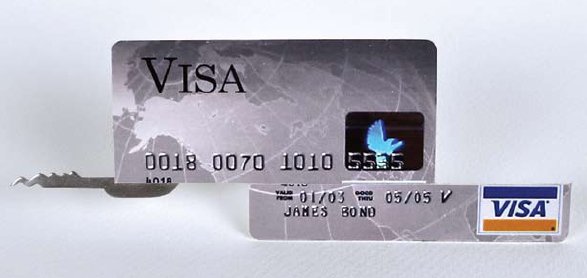
My flexible friend. Handy for opening any lock, and paying for lunch, too.
FABERGÉ EGGS TO FAKE CROCS
My trusty Seiko survived to accompany me in For Your Eyes Only, where it received digital message read-outs and operated as a two-way radio/transmitter for voice communications, much to the Prime Minister’s surprise.
The main object of the film’s story was to locate and retrieve the Automatic Targeting Attack Communicator (ATAC), which had been lost when the British spy ship St Georges was sunk. This device controlled all of Britain’s Polaris nuclear submarines and could either render them inoperative or coordinate them against major Western cities or, heaven forbid, against Britain herself. In its pursuit I helped Q load up the Identigraph device to assemble a photo of our suspect by selecting characteristics from a variety of lists including hair colour, hairstyle, nose form, style of eyeglasses etc. Poor Desmond Llewelyn had terrible trouble setting up the machine and remembering his complicated lines, so I took over the technical end and it worked rather well.
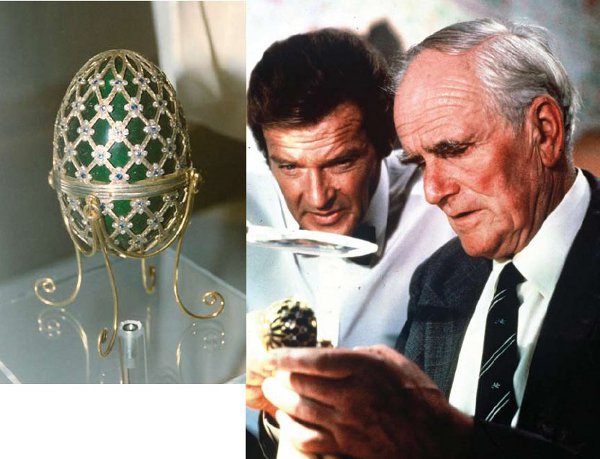
In Octopussy, Q fixed a listening and homing device inside the Fabergé egg.
When Octopussy came around, the Seiko graduated to containing a universal radio direction finder, working in conjunction with a listening device inside Bond’s fountain pen and the fake Fabergé egg. I also employed loaded backgammon dice – though not in my games with Cubby – and a Mont Blanc fountain pen that contained a mixture of nitric and hydrochloric acids. Have you seen the price of refills for those things?
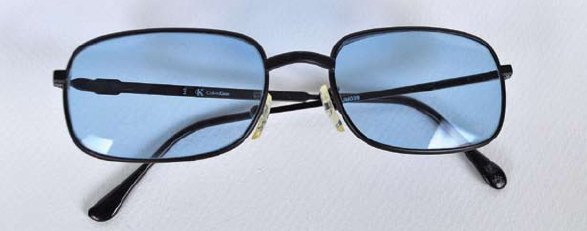
An innocent-looking pair of CK glasses. But touch a switch and it sets off a detonator in Jim’s P99 gun.
One of the fun gadgets – or is it a mode of transport? – was the ‘fake crocodile’, actually a miniature motorboat used to get Jimmy to Octopussy’s Island. I bravely climbed into it for the close-ups, but allowed Paul Weston to drive it in the scene, just in case a real frisky crocodile wandered into shot. That might have been tricky!
In my last outing as Jim I was armed with all manner of useful gizmos. There were polarizing sunglasses that let Jim see clearly through tinted glass; a ring containing a miniature camera; a billfold that used ultraviolet light to read previously written material by picking up the indentations of pen marks on paper; a bug detector contained within an electric razor; a credit card for popping open locked windows; a tracking device to locate a stolen microchip buried in the snow; and, of course, SNOOPER – one of Q’s surveillance inventions in the form of a small, animal-like remote-controlled camera that can transmit audio/video.
GADGET HEAVEN
After my tenure as 007 ended, Q stayed on to look after Timothy Dalton and Pierce Brosnan. Their haul of gadgets was ever impressive and ingenious. In The Living Daylights Q produced a Philips Keychain, which had become widely popular in locating lost keys. However, Q’s contained some non-standard extras, including a capsule of stun gas, activated by the first bars of ‘Rule, Britannia’, and an explosive charge set off by a wolf whistle! The keychain also featured a lock-pick, effective on ninety per cent of the world’s locks …
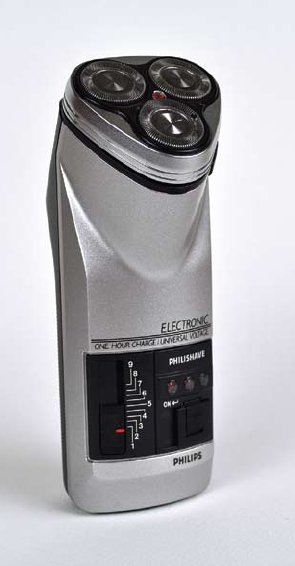
This innocent-looking electric shaver is actually a sophisticated bug detector in A View To A Kill.
In his second film with Timothy Dalton, Q found himself in the field and carried a bag of everyday travel items including Dentonite Toothpaste – actually plastic explosive with the detonator disguised as a packet of cigarettes. There was also a wonderful gun that could be programmed to fire for only one person, and an exploding alarm clock – guaranteed never to wake up anyone who uses it.
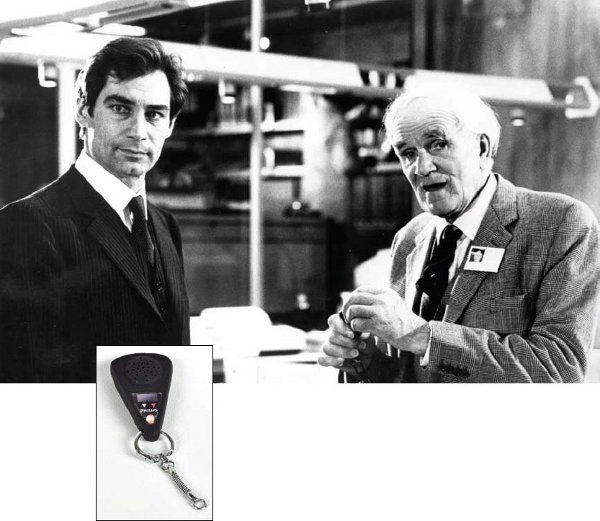
Q with my successor, Timothy Dalton, who was receiving a briefing on the key finder, which was operated by a whistle.
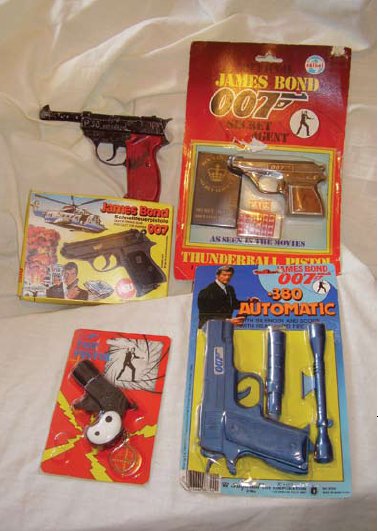
Of course there were toy guns produced to tie in with the films. They came in all shapes and sizes.
When Pierce donned the famous tuxedo it was accompanied by a leather belt that concealed a piton capable of firing up to seventy-five feet of high-tensile wire, that could take the weight of an average person. Then there was a Parker pen for his top pocket that contained a class-four grenade. A new wristwatch in the shape of Omega Seamaster Professional – with laser cutter and remote detonator – completed the ensemble.
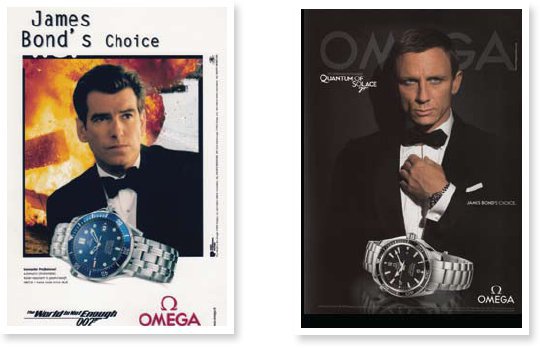
Omega remained Jimbo’s watch of choice throughout Pierce’s tenure – and still features with Daniel in the role.
When Tomorrow Never Dies came around, the burgeoning mobile-phone market was tapped and Ericsson supplied a concept model loaded with a variety of features, including a 20,000-volt stun gun, and a nifty fingerprint analyser. The best feature in my view was the remote control for Jimmy’s BMW – a masterpiece that no agent should be without.
With the fortieth anniversary of the films in 2002, the producers decided it was time to pay homage to some of the gadgets laid up in storage from the previous twenty films and have Bond wander around them, picking up a wristwatch (with explosive detonator and laser cutter) and a ring that can shatter bulletproof glass.
Since Casino Royale in 2006, the character of Q and his lab have been absent from the films. While Bond is still outfitted with a number of gadgets, they seem less futuristic and awe-inspiring and are based on technology already commercially available rather than Q’s flights of fancy. The cellphones are smarter – the one in Quantum Of Solace had an identification imager that could compile a composite facial image. I wonder if that was on contract or pay-as-you-go?
One thing that is constant is Jimmy’s love of a good watch – and let’s face it, it’s his watch that has got him out of several nasty situations. I used to wear an Omega all the time, and still do wear my limited-edition Submariner on occasion, but my main timepiece is a Breitling, which I used in a commercial for the Hanson Trust in Ireland. After the third and last day of filming, I asked my son Christian (who was assistant director) to take it back to the production office.
‘No, keep it, it’s yours,’ he said. There was no way I was going to pinch a £5,000 watch!
‘No,’ he said, ‘Kristina saw you admiring it and has bought it for you.’
My wife also bought me a Piaget watch, which I use when in formalwear as it’s very lightweight and thin. My wife, as well as having great taste, is also very generous.